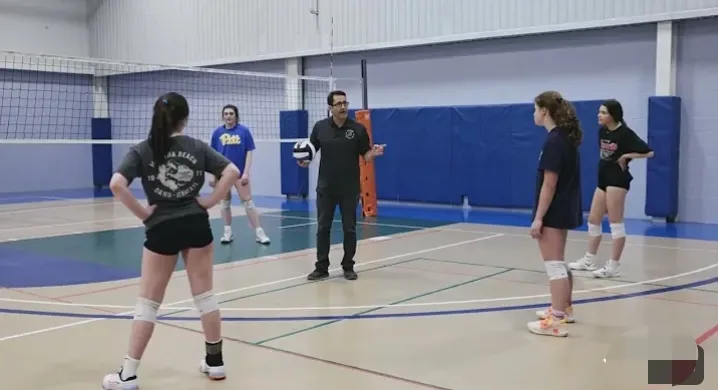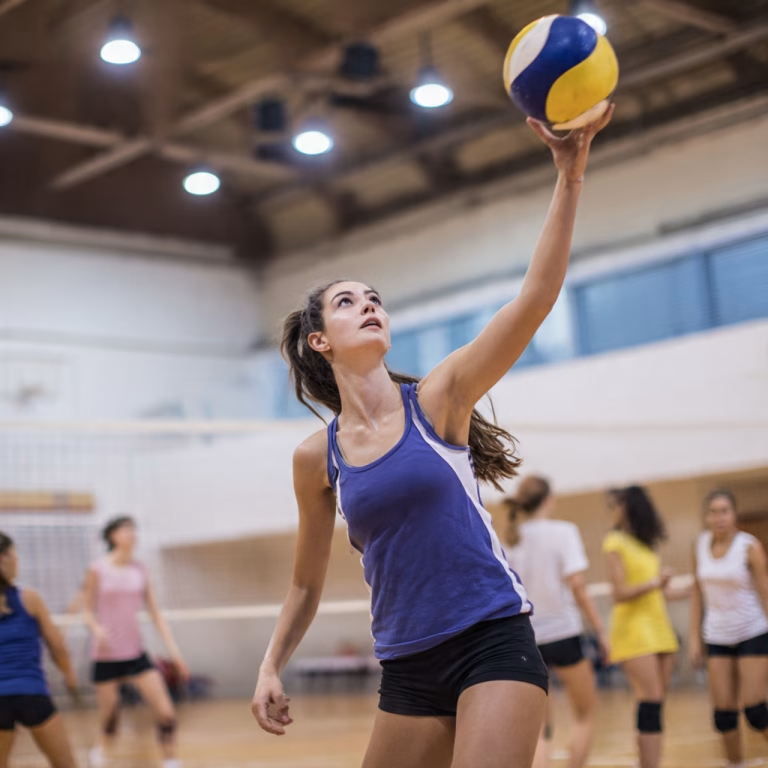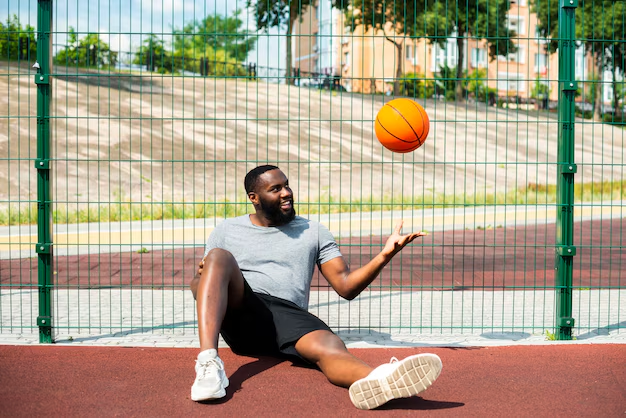Learning volleyball for the first time can feel overwhelming, but mastering a few essential volleyball drills for beginners is the perfect way to build confidence and improve your skills. These basic drills help develop key techniques such as passing, serving, and setting, which are the foundation of the game. By practicing consistently, beginners can quickly feel more comfortable on the court and contribute to their team’s success.
See Also: 8 Best Drills to Do at Volleyball Tryouts
Volleyball Drills for Beginners
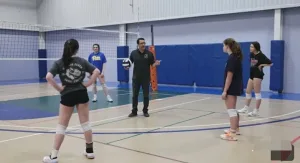
1. Dynamic Stretches Drills
Start with simple exercises like arm circles, lunges, and high knees. These movements help improve flexibility and blood circulation, making you more agile during the game.
2. Light Footwork Drills
Use a few cones or markers on the court to practice quick side-to-side movements. This will help build your agility, which is crucial for reacting to the ball quickly.
The above drills are Warm-Up and Conditioning for Beginners. Before going into skill-based drills, it’s important to warm up and get your body moving. A proper warm-up reduces the risk of injury and helps prepare your muscles for action.
3. Forearm Pass (Bump) Basics
Begin by focusing on your stance. Stand with your knees slightly bent and your arms out in front of you. When the ball comes your way, keep your arms together and use your forearms to direct the ball upwards.
4. Partner Passing Drills
Grab a partner and practice passing the ball back and forth. The goal is to keep the ball in the air and control it with soft touches. This drill helps improve your accuracy and consistency.
5. Wall Passing Drill
If you’re practicing alone, find a wall and pass the ball against it repeatedly. This drill helps beginners improve their reaction time and ball control.
These drills are Passing drills suitable for beginners: Passing, also known as bumping, is one of the most important skills in volleyball. For beginners, learning how to pass correctly can make all the difference during games.
See Also: 7 Types of Passes in Volleyball
6. Basic Hand Positioning
To set correctly, place your hands above your forehead, forming a triangle shape with your thumbs and index fingers. Use your fingers, not your palms, to push the ball upward.
7. Target Setting Drill
With a partner or a target on the wall, practice setting the ball to the same spot consistently. Focus on your hand placement and follow through to keep the ball in control.
8. Repetition Drill
Consistency is key for setters. Continuously set the ball to yourself or against a wall to develop accuracy.
These are the setting drills for beginners. Setting the ball is essential for creating scoring opportunities. A good setter can place the ball perfectly for their teammates to spike.
9. Underhand Serve Drill
This is the easiest serve for beginners. Stand behind the service line, hold the ball in one hand, and swing your other hand in an upward motion to hit the ball over the net. Practice aiming for different zones on the court.
10. Overhand Serve
Once you’re comfortable with the underhand serve, try the overhand serve. Toss the ball slightly in the air and strike it with the heel of your hand. Focus on keeping the ball low and controlled.
11. Serve to Target Drill
Set up cones or targets on the other side of the net and aim to hit them. This drill helps with accuracy and control.
These are the Best Volleyball Drills for Beginners: Serving is one of the few skills in volleyball where you have complete control over the ball. Beginners should focus on accuracy and proper technique.
12. Approach and Arm Swing Drill
Start by practicing your footwork. Use a three-step approach (left-right-left for right-handers) before jumping. As you jump, swing your arm back and snap it forward to hit the ball.
13. Hitting Against the Wall
For solo practice, hit the ball against the wall to practice your timing and arm swing.
14. Toss and Spike Drill
Work with a partner who tosses the ball in front of you while you practice spiking. Focus on hitting the ball with power but also aim for accuracy.
This drill is Hitting Drills for Beginners. Hitting, or spiking, is one of the most exciting parts of volleyball. For beginners, the focus should be on timing and approach.
15. Jump and Block mechanics
Stand at the net and practice jumping straight up with your arms extended, ready to block. Focus on timing your jump so that you meet the ball at its highest point.
16. Wall Block Drill
Use a wall to practice your blocking form by jumping and touching specific spots with your hands, simulating blocking an attack.
These are blocking drills for beginners. Blocking is a key defensive skill in volleyball. It’s all about timing and positioning to stop the opponent’s attack.
17. Digging Drill
Work with a partner to practice digging balls that come your way. Stay low and focus on using your forearms to bump the ball upward.
18. Pepper Drill
In this drill, you and a partner bump, set, and spike the ball back and forth. It’s a great way to improve reflexes and hand-eye coordination.
19. Roll and Dive Drill
Practice rolling and diving to save the ball from hitting the ground. Start slowly, then build up speed to improve your reaction time.
They are the best volleyball drills for beginners: Defense is crucial in volleyball, and every player needs to know how to react quickly and keep the ball in play.
See Also: Mastering Rotational Defense in Volleyball: A Comprehensive Guide
15 Beginner-Friendly Volleyball Drills
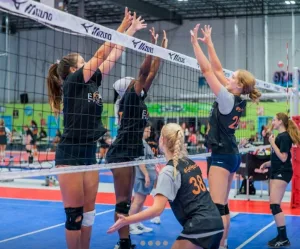
Below are 15 beginner-friendly volleyball drills that not only teach basic skills like serving, passing, and hitting but also keep young players enthusiastic about the game.
1. Energy Check Drill: Volleyball Drills for Beginners
When team energy dips, it’s important to get players back on track. The Energy Check Drill involves players placing a volleyball between their knees and clapping out a rhythm on their thighs and hands, followed by an enthusiastic shout of “Volleyball!” This drill boosts energy and team spirit while keeping everyone focused.
2. Down Ball Hitting Drill: Volleyball Drills for Beginners
Warm up your players’ hitting skills with the down ball hitting drill. Players position the ball in front of their hitting shoulder and use the entire hand to strike it against the floor. This drill improves hand-eye coordination and helps players understand how to use their entire hitting hand for better ball control.
3. Toss-Up Setting Drill: Volleyball Drills for Beginners
In this drill, players practice proper ball and body positioning for setting. Players stand with one foot slightly ahead of the other, toss the ball above their heads, and catch it with their fingers spread. This drill emphasizes proper hand positioning for successful sets.
4. Fizzles Setting Drill: Volleyball Drills for Beginners
This fun drill helps players get a better feel for the ball. Players toss the ball above their heads and set it low to themselves for three reps. The repetition helps them improve their touch and control while setting.
5. Four Sets Drill: Volleyball Drills for Beginners
The Four Sets Drill focuses on controlling the ball from a low to high position. Players set a low ball to themselves for three reps, followed by one high set. This drill builds confidence in ball handling and encourages players to control the pace of the ball.
6. Low Catch Passing Drill
In this beginner passing drill, players work on handling the ball in a low-body position. Players toss the ball high into the air, let it bounce once, then catch it in a low base just before it hits the floor a second time. This drill improves reaction time and body positioning for passing.
7. Volleyball Burpee Passing Drill
This drill combines the low-catch passing technique with movement. After catching the ball in a low position, players tap the ball on the floor to the right, middle, and left of their bodies before popping up to a standing position. It’s a great way to teach players to stay low and move quickly with the ball.
8. Deliver and Pop Serve Drill
Teaching players how to serve starts with the basics. In this drill, players practice delivering the ball at the top of their reach and dropping it to the floor. Next, they add a small toss and contact the ball with a “pop” from their serving hand. This drill helps beginners build confidence in their serve technique.
9.10 to Kill Ball Control Drill
This cooperative drill involves two teams of six working together to keep the ball in play for 10 consecutive exchanges over the net. After 10 passes, either team can attempt a “kill” to score a point. The first team to reach five big points wins, encouraging teamwork and ball control.
10. Popcorn Ball Control Drill
Players practice ball control with extended arms, bouncing the ball from arm to arm with a single bounce. As they progress, they can move to a double bounce. This drill helps players become more comfortable with controlling the ball using both arms.
11. Big Kernel Little Kernel Ball Control Drill
In this variation of the popcorn drill, players use a little bounce followed by a big bounce to work on controlling the ball. This pattern helps players understand how to adjust their touch and control the ball in different situations.
12. Five-Second Rule Ball Control Drill
Challenge your players with the five-second rule drill. Similar to the popcorn drill, players must touch the floor on alternating high bounces. This drill sharpens reflexes and promotes better ball control during quick transitions.
13. Muscle Memory Throws Drill
This partner drill focuses on building muscle memory for proper hitting and serving techniques. Players practice four different muscle memory throws to develop the correct motions needed for powerful serves and spikes.
14. Serve Receive Wave Drill
This drill focuses on improving serve reception. Servers send balls across the net while passers work on returning the ball to a designated target. After 10 successful passes, servers and passers swap positions. This drill helps players get comfortable with receiving serves and transitioning into offensive play.
15. Flip Flop Passing Drill
Two players take turns tossing balls to a passer positioned between them. After passing the ball to the first tosser, the passer rotates 180° to receive and return the ball to the second tosser. This drill works on quick reaction time and body rotation, key skills in passing during fast-paced games.
See Also: Underhand Serve in Volleyball: Meaning and Step-by-Step Guide
Conclusion
Mastering these volleyball drills for beginners will help you develop the fundamental skills needed to succeed on the court. Whether you’re practicing passing, setting, serving, or hitting, consistency is the key to improving. By focusing on these basic drills, you’ll build the confidence to play volleyball effectively and enjoy the game even more.
FAQs
1. What are the most important volleyball drills for beginners?
The most important volleyball drills for beginners focus on passing, serving, setting, and basic defensive techniques. Passing drills like partner passing and wall passing are great for improving ball control, while serving drills help beginners practice accuracy. Setting and hitting drills are also key to developing well-rounded skills.
2. How often should beginners practice volleyball drills?
Beginners should aim to practice volleyball drills at least 3 to 4 times a week to see noticeable improvement. Consistent practice helps build muscle memory and enhances your ability to react quickly in game situations.
3. Can I practice volleyball drills alone?
Yes, many volleyball drills can be practiced alone. Wall passing, serving, and hitting against the wall are great solo drills that help improve ball control, accuracy, and timing. If possible, practice with a partner for drills like setting and peppering to work on teamwork and communication.
4. What is the easiest volleyball serve for beginners?
The underhand serve is the easiest volleyball serve for beginners. It requires less coordination than an overhand serve, making it easier to control the ball’s direction and height. Once you master the underhand serve, you can move on to more advanced serving techniques.
5. How can I improve my volleyball passing skills?
To improve your passing skills, practice forearm passing drills regularly. Start with partner passing or wall passing drills to work on your accuracy. Focus on keeping your arms straight and using your legs to generate power. Over time, you’ll notice better ball control and more consistent passes.
By incorporating these volleyball drills for beginners into your practice routine, you’ll quickly develop the skills and confidence needed to play volleyball at a higher level.

